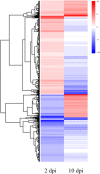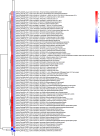Functional categorization of de novo transcriptome assembly of Vanilla planifolia Jacks. potentially points to a translational regulation during early stages of infection by Fusarium oxysporum f. sp. vanillae
- PMID: 31703622
- PMCID: PMC6839141
- DOI: 10.1186/s12864-019-6229-5
Functional categorization of de novo transcriptome assembly of Vanilla planifolia Jacks. potentially points to a translational regulation during early stages of infection by Fusarium oxysporum f. sp. vanillae
Abstract
Background: Upon exposure to unfavorable environmental conditions, plants need to respond quickly to maintain their homeostasis. For instance, physiological, biochemical and transcriptional changes occur during plant-pathogen interaction. In the case of Vanilla planifolia Jacks., a worldwide economically important crop, it is susceptible to Fusarium oxysporum f. sp. vanillae (Fov). This pathogen causes root and stem rot (RSR) in vanilla plants that lead to plant death. To investigate how vanilla plants, respond at the transcriptional level upon infection with Fov, here we employed the RNA-Seq approach to analyze the dynamics of whole-transcriptome changes during two-time frames of the infection.
Results: Analysis of global gene expression profiles upon infection by Fov indicated that the major transcriptional change occurred at 2 days post-inoculation (dpi), in comparison to 10 dpi. Briefly, the RNA-Seq analysis carried out in roots found that 3420 and 839 differentially expressed genes (DEGs) were detected at 2 and 10 dpi, respectively, as compared to the control. In the case of DEGs at 2 dpi, 1563 genes were found to be up-regulated, whereas 1857 genes were down-regulated. Moreover, functional categorization of DEGs at 2 dpi indicated that up-regulated genes are mainly associated to translation, whereas down-regulated genes are involved in cell wall remodeling. Among the translational-related transcripts, ribosomal proteins (RPs) were found increased their expression exclusively at 2 dpi.
Conclusions: The screening of transcriptional changes of V. planifolia Jacks upon infection by Fov provides insights into the plant molecular response, particularly at early stages of infection. The accumulation of translational-related transcripts at early stages of infection potentially points to a transcriptional reprogramming coupled with a translational regulation in vanilla plants upon infection by Fov. Altogether, the results presented here highlight potential molecular players that might be further studied to improve Fov-induced resistance in vanilla plants.
Keywords: Biological defense; Biotic stress; Ribosomal proteins; Transcriptional reprogramming; Translational regulation.
Conflict of interest statement
The authors declare that they have no competing interests.
Figures







Similar articles
-
Differential Responses of Vanilla Accessions to Root Rot and Colonization by Fusarium oxysporum f. sp. radicis-vanillae.Front Plant Sci. 2015 Dec 18;6:1125. doi: 10.3389/fpls.2015.01125. eCollection 2015. Front Plant Sci. 2015. PMID: 26734032 Free PMC article.
-
Genome-wide identification of the glutamate receptor-like gene family in Vanilla planifolia and their response to Fusarium oxysporum infection.Plant Signal Behav. 2023 Dec 31;18(1):2204654. doi: 10.1080/15592324.2023.2204654. Plant Signal Behav. 2023. PMID: 37096589 Free PMC article.
-
Transcriptome dynamics associated with resistance and susceptibility against fusarium head blight in four wheat genotypes.BMC Genomics. 2018 Aug 29;19(1):642. doi: 10.1186/s12864-018-5012-3. BMC Genomics. 2018. PMID: 30157778 Free PMC article.
-
Vanilla beyond Vanilla planifolia and Vanilla × tahitensis: Taxonomy and Historical Notes, Reproductive Biology, and Metabolites.Plants (Basel). 2022 Nov 30;11(23):3311. doi: 10.3390/plants11233311. Plants (Basel). 2022. PMID: 36501350 Free PMC article. Review.
-
A Historical Review of the Artificial Pollination of Vanilla planifolia: The Importance of Collaborative Research in a Changing World.Plants (Basel). 2024 Nov 15;13(22):3203. doi: 10.3390/plants13223203. Plants (Basel). 2024. PMID: 39599412 Free PMC article. Review.
Cited by
-
Specific alterations in riboproteomes composition of isonicotinic acid treated arabidopsis seedlings.Plant Mol Biol. 2023 Mar;111(4-5):379-392. doi: 10.1007/s11103-022-01332-2. Epub 2023 Feb 15. Plant Mol Biol. 2023. PMID: 36790538 Free PMC article.
-
Implication of ribosomal protein in abiotic and biotic stress.Planta. 2025 Mar 11;261(4):85. doi: 10.1007/s00425-025-04665-6. Planta. 2025. PMID: 40067484 Review.
-
Transcriptomic analysis reveals molecular phenological changes during the flower-to-fruit transition in Vanilla planifolia Andrews (Orchidaceae).BMC Plant Biol. 2025 Apr 5;25(1):437. doi: 10.1186/s12870-025-06476-z. BMC Plant Biol. 2025. PMID: 40186135 Free PMC article.
-
Differential Participation of Plant Ribosomal Proteins from the Small Ribosomal Subunit in Protein Translation under Stress.Biomolecules. 2023 Jul 21;13(7):1160. doi: 10.3390/biom13071160. Biomolecules. 2023. PMID: 37509195 Free PMC article.
-
Proteome Mapping of South African Cassava Mosaic Virus-Infected Susceptible and Tolerant Landraces of Cassava.Proteomes. 2021 Oct 23;9(4):41. doi: 10.3390/proteomes9040041. Proteomes. 2021. PMID: 34842800 Free PMC article.
References
MeSH terms
Substances
Grants and funding
LinkOut - more resources
Full Text Sources
Molecular Biology Databases

